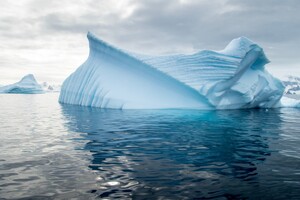The Northern Sea Route is currently one of the few ways to sail through the Arctic.

One of the few ways ships can go across the Arctic, controlled by Russia. But by the middle of this century, melting ice could lead to a new route that will be beyond Russian control, according to New Scientist.
The Northern Sea Route stretches from the Kara Sea to the Bering Strait, covering most of Russia's 24,000-kilometer Arctic coast. The traffic on this route cannot be called intensive now: the total volume of navigation in the Arctic last year was equivalent to one or two days in the Suez Canal. But melting ice caused by global warming could make Arctic shipping more attractive. Some polar routes are twice as short as usual.
Read also: Warming in the Arctic: the temperature in the Barents Sea “scales”
One of the obstacles to increasing international traffic on the existing route controlled by Russia is the large number of fees and restrictions. According to Amanda Lynch of Brown University in Rhode Island, one shipping operator said: “We are not afraid of icebergs. We are afraid of the icebergs of Russian paperwork. “
The legal basis for Russia's jurisdiction follows from the provisions of the United Nations Convention on the Law of the Sea, which gives countries jurisdiction over ice-covered waters within 200 nautical miles (300 kilometers) of their coast, an area known as the exclusive economic zone. But Lynch notes that melting sea ice and rising sea levels have destabilized those boundaries.
Lynch and Charles Norchi of the University of Maine modeled how different global warming scenarios would affect the jurisdiction of Arctic shipping routes. It turned out that for all but the most controlled emission scenarios, melting ice will open the way over the Northern Sea Route for at least a month a year, starting in 2035-2065, depending on climate change scenarios.
Vessels traveling on this route will not be subject to Russian restrictions on the Northern Sea Route. In addition, ordinary ships will be able to sail without the help of icebreakers.
However, this will be provided that Russia and other countries comply with international norms and laws at sea.
“I have little confidence that Russia will stay within its exclusive economic zone in what they see as their right to enforce their jurisdiction over ice-covered waters,” said Scott Stephenson of RAND Corporation, a US think tank. .
Norchi also emphasizes that the Russian invasion of Ukraine has changed Arctic cooperation, from research projects to search and rescue operations. In March, seven of the eight countries suspended their participation in the Russian-led Arctic Council.. This will be due to climate change and global warming in the planet's polar region.
Scientists believe that this could cause extreme weather events in the United States and Europe. Siberian tundra may disappear due to global warming As temperatures rise, forests will occupy northern areas. The snow-capped Alps are turning green and the changes are already visible from space This is due to global warming. Eating insects can help cope with climate change: how it is possible Scientists call insects an important source of protein. Davos 2022: “Green Transition” and digitalization will define the labor market of the future At the same time, “traditional spheres” of the economy remain equally important.




